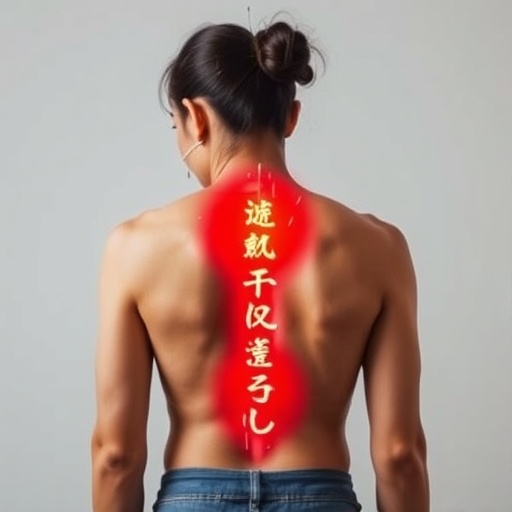In recent years, acupuncture has gained global recognition as an alternative treatment modality, especially among middle-aged and older adults experiencing low back pain. The rising interest is markedly evident in China, where traditional practices are juxtaposed with modern medical solutions. A recent study by Lei, Xia, and Huang sheds light on the various factors driving the utilization of acupuncture in this demographic, a subject that resonates deeply within the evolving landscape of healthcare.
Low back pain is an increasingly prevalent ailment that impacts countless lives, resulting in substantial physical, emotional, and financial burdens. As people age, the prevalence of musculoskeletal disorders escalates, making chronic conditions like low back pain particularly concerning. Economic factors, burgeoning healthcare costs, and the limitations of conventional treatments have ignited a proclivity towards complementary and alternative medicine (CAM). This trend underscores an urgent need to comprehend why certain populations gravitate towards options like acupuncture.
The study unveiled that older adults in China frequently turn to acupuncture, citing a myriad of reasons. One of the primary motivations identified was the cultural acceptance of acupuncture as part of holistic health and wellness. The historical underpinnings of this practice weave its way into the fabric of Chinese society, making it more than just a treatment; it’s deeply entrenched in the cultural psyche. As such, acupuncture often becomes a preferred choice, embodying a blend of tradition and modernity that resonates with patients.
Another significant factor influencing the uptake of acupuncture among the middle-aged and older population is the perception of efficacy. Many individuals reported anecdotal evidence of acupuncture leading to pain relief and improved mobility, which significantly affects their quality of life. Particularly for individuals who have become disillusioned with traditional medicine, the promise of relief through acupuncture can appear almost transformative. This sustained interest has led to increased research into the techniques and methodologies of acupuncture, further legitimizing its use in contemporary practice.
Moreover, socioeconomic conditions play a vital role in treatment decisions. Accessibility to healthcare facilities, the cost of treatments, and the availability of trained practitioners can either facilitate or hamper the adoption of acupuncture as a viable option. With health systems under strain due to aging populations, acupuncture is often positioned as a cost-effective treatment alternative. For many, especially those facing economic constraints, the relative affordability of acupuncture compared to pharmaceutical intervention or surgical procedures makes it an attractive option.
An integral aspect that is often overlooked is the social dimension influencing the choice to pursue acupuncture treatment. Community support, familial traditions, and peer endorsements create a social framework that encourages individuals to explore acupuncture as viable treatment. Research indicates that when family members or friends vouch for the effectiveness of acupuncture, potential patients are more likely to take the plunge into this unfamiliar territory. This collective belief fosters a stigma-free environment that nurtures the acceptance and increase of acupuncture usage.
The study did not shy away from discussing potential barriers to acupuncture treatment. One glaring issue is the lack of standardized practices and regulations governing acupuncture across China. This inconsistency can lead to skepticism among the population and potential misinformation regarding its effectiveness. Furthermore, the variance in expertise among practitioners can pose questions about the quality and safety of acupuncture, further complicating its acceptance in certain circles.
Additionally, educational factors come into play. Awareness and understanding of acupuncture methods can significantly influence an individual’s decision to pursue treatment. Respondents who had previous knowledge or exposure to acupuncture were generally more inclined to utilize it. This correlation highlights the necessity for healthcare providers to engage in comprehensive discussions regarding alternative treatment modalities and their applicability.
An important takeaway from Lei, Xia, and Huang’s findings is the need for continued education within medical institutions regarding complementary therapies. By integrating acupuncture into traditional medical curricula, it may be possible to diminish misconceptions and enhance the collaborative relationship between conventional and alternative medicine. Interdisciplinary approaches are the future of medicine, allowing for the pooling of resources and knowledge, ultimately leading to improved patient outcomes.
Furthermore, it’s crucial to note how modern technological advancements have impacted acupuncture. With the advent of telemedicine, patients now have unprecedented access to acupuncture specialists, often from the comfort of their homes. Online platforms have made it easier to connect patients with practitioners, share experiences, and educate about the standards of care. Such developments offer a route to demystify acupuncture and position it as an accessible option for many suffering from chronic pain.
In conclusion, the study conducted by these scholars offers a multifaceted view of why acupuncture continues to gain traction among middle-aged and older adults dealing with low back pain in China. The coalescence of cultural acceptance, perceived effectiveness, economic considerations, social influence, and education underlies a growing trend that may encourage wider adoption of acupuncture globally. The implications of this trend ripple throughout both the healthcare landscape and emphasize the need for further interdisciplinary dialogue and research.
As acupuncture finds its footing in modern medicine, it simultaneously urges healthcare systems to reevaluate approaches toward chronic conditions. The insights provided by the study are timely and reinforce the importance of understanding patient preferences, ultimately bridging the gap between traditional practices and contemporary medical needs.
In essence, acupuncture embodies a journey of healing that transcends mere physical relief. It invites individuals to explore the interconnected layers of mind, body, and community in their quest for wellness. Through understanding the factors influencing its usage, we can fortify the future of acupuncture as an integral part of holistic health and wellness strategies. Embracing such alternatives could prove invaluable as societies navigate ever-evolving healthcare landscapes.
Subject of Research: Factors associated with acupuncture treatment use among middle-aged and older adults with low back pain in China.
Article Title: Factors associated with acupuncture treatment use among middle-aged and older adults with low back pain in China.
Article References: Lei, Y., Xia, X., Huang, X. et al. Factors associated with acupuncture treatment use among middle-aged and older adults with low back pain in China. BMC Complement Med Ther 25, 343 (2025). https://doi.org/10.1186/s12906-025-05086-4
Image Credits: AI Generated
DOI: 10.1186/s12906-025-05086-4
Keywords: acupuncture, low back pain, alternative medicine, China, middle-aged, older adults, healthcare, cultural practices, socioeconomic factors
Tags: acupuncture efficacy and patient motivationacupuncture for low back painacupuncture utilization among middle-aged adultsalternative treatment modalities for painbenefits of acupuncture for chronic paincultural acceptance of acupunctureeconomic factors affecting healthcare choiceshealthcare trends in Chinaholistic health approaches in aging populationsmusculoskeletal disorders in older adultsrising interest in complementary medicinetraditional Chinese medicine practices





